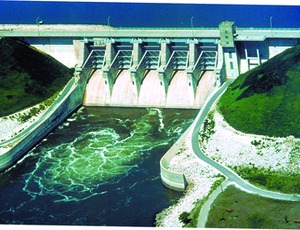
Missouri River Energy Services plans to build a 36.4-MW hydroelectric plant on an existing dam near Pella, Iowa. The project is indicative of a slow but developing trend in the U.S.
MRES, a Sioux Falls, S.D.-based municipal utility power supplier, has hired MWH for engineering work on the $220-million project, Tom Heller, MRES chief executive officer, said on Sept. 16. MWH is an engineering consultant headquartered in Broomfield, Colo.
MRES plans to build the Red Rock hydroelectric facility on the Des Moines River next to the spillway on a Corps of Engineers dam. The facility could produce up to 55 MW, depending on water flow. MRES expects to start building the project in 2013 and bring it on line by early 2016. Once built, the facility would be the state's second-largest hydroelectric project.
MRES expects to issue a solicitation in September 2012 for a general contractor to build the Red Rock project, which includes constructing a powerhouse next to the existing spillway that will house three 12.13-MW turbines, according to Bill Radio, MRES spokesman. A high rate of water flow could push production to 55 MW.
Earlier this year, the Federal Energy Regulatory Commission (FERC) granted a license for the Red Rock project to CRD Hydroelectric, a Nelson Energy subsidiary, which sold the project to MRES. Built and operated by MRES, the project will be owned by Western Minnesota Municipal Power Agency, which finances the construction and acquisition of generation and transmission facilities for MRES.
“The [Red Rock hydroelectric project, or RRHP] gives MRES another generating resource in our ongoing efforts to diversify our resource portfolio,” says Tom Heller, MRES CEO. “The long-term life of a hydro facility such as RRHP allows MRES to spread the costs over an extended period of time to enable us to keep our costs reasonably stable through the addition of a base-load, renewable resource.”
More utilities and developers are looking to add generating capacity to existing dams, says Matt Nocella, spokesman for the National Hydropower Association (NHA). There are about 8,000 dams in the U.S., but only 3% of them can produce power, he says. The dams that do not make electricity could produce about 12,600 MW, he says.
Last year, FERC issued 12 permits to add 110 MW onto existing dams; since July of this year, the agency has granted nine more permits that total 35 MW. While FERC is issuing more permits, little hydroelectric capacity is being built. Only four projects totaling 16 MW were built last year, and three projects totaling 16 MW have been added this year.
Hydroelectric projects face two major barriers, Nocella says. First, they have high up-front capital costs. Second, they face regulatory hurdles and a permitting process that can take six years to complete.
NHA is pressing Congress to cut to two years the permitting process for adding capacity to existing dams, Nocella says, enabling “a large amount of electric capacity without building new impoundments.”
Retrofits will soon get a major boost. American Municipal Power, which serves a seven-state region, is building four generating projects on existing Ohio River dams. The projects total 313 MW, making them the largest run-of-the-river development effort in the U.S. Construction is under way, with two projects slated to be on line in 2014 and two others in 2015.


Post a comment to this article
Report Abusive Comment